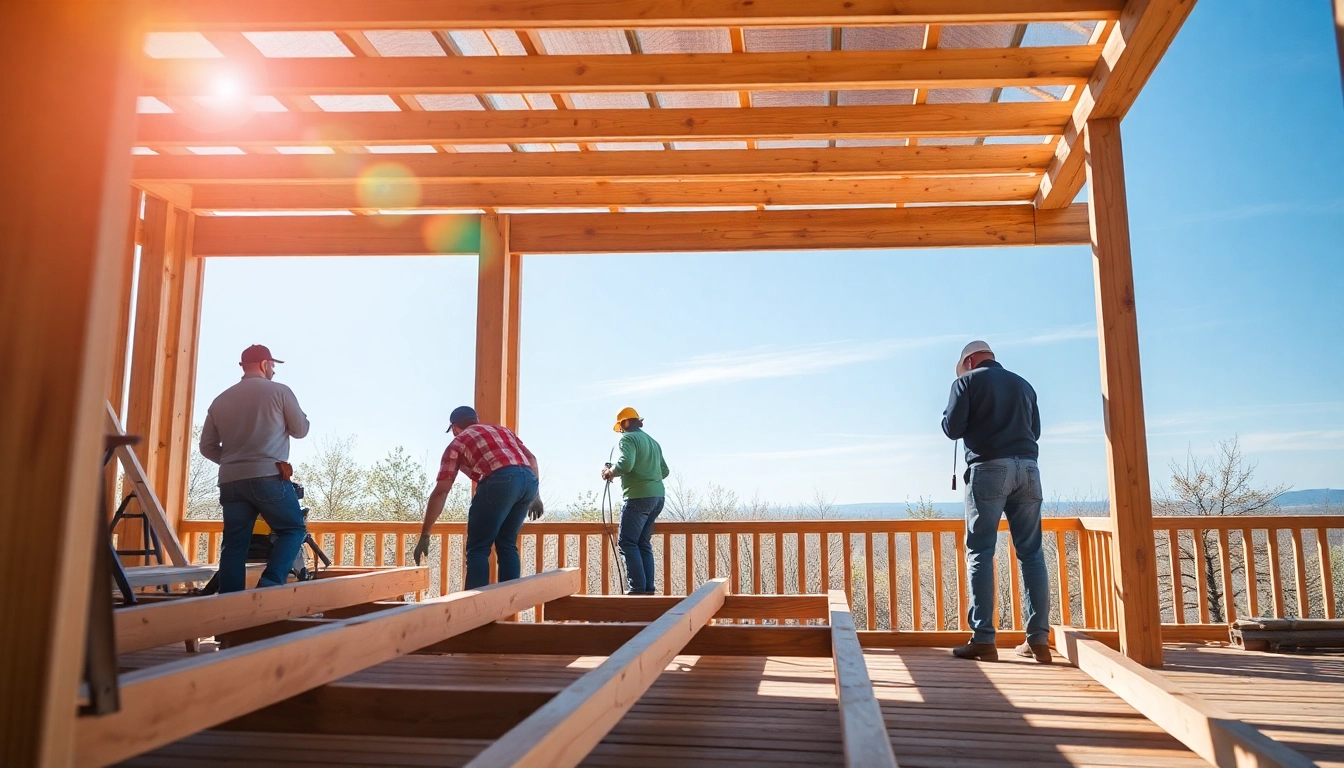Introduction to Deck Construction
Deck construction is a gratifying home improvement project that enhances the aesthetic appeal and functional space of your property. Whether you’re considering building a simple step-down deck or a grand multi-level space for entertaining, understanding the key elements involved in deck construction is essential. This comprehensive guide will walk you through not only the practical steps to build a deck, but also the planning, material selection, budgeting, and maintenance necessary for a successful project that stands the test of time.
Understanding Deck Types
When embarking on a deck construction project, it’s crucial to first understand the various types of decks available. Each style can significantly influence the design, material choices, and construction methods. Below, we outline the most common deck types:
- Attached Decks: These decks are connected to the house and typically share a ledger board. They are generally easier and less expensive to build since they require less structural support.
- Freestanding Decks: Unlike attached decks, freestanding decks are independent structures. Ideal for sloped backyards or challenging terrains, they often require additional support and careful planning.
- Multi-level Decks: Featuring multiple levels connected by stairs, these decks provide an interesting design and can accommodate various outdoor living areas, such as seating and dining.
- Wrap-around Decks: These decks extend around the house, blending seamlessly with outdoor spaces to create an expansive area for relaxation or entertainment.
- Rooftop Decks: Common in urban areas, rooftop decks utilize flat roofs to create outdoor living spaces that offer unique views and experiences.
Benefits of Building a Deck
Building a deck offers numerous benefits that enhance both your living experience and property value. Here are some of the key advantages:
- Increased Space: Decks provide additional living space outdoors, ideal for gatherings, barbecues, or simply enjoying the fresh air.
- Enhanced Property Value: A well-constructed deck can improve your home’s resale value, appealing to potential buyers looking for outdoor living options.
- Customization Options: Decks can be customized in terms of design, materials, and layout, allowing personal flair and suitability for your lifestyle.
- Connection to Nature: A deck extends your living space into nature, providing an excellent venue for relaxation, entertainment, and outdoor activities.
Common Materials Used in Deck Construction
Selecting the right materials is essential for deck construction, as they affect durability, maintenance, and overall appearance. Here are the most common materials:
- Pressure-Treated Wood: Often used for framing and decking, this affordable option is treated to resist rot and insects but requires regular maintenance, including staining and sealing.
- Cedar and Redwood: These naturally resistant woods offer beautiful aesthetics and require less treatment than pressure-treated wood, though they may be more expensive.
- Composite Decking: Made from a mix of wood fiber and plastic, composite decking is durable and low-maintenance, available in various colors and styles.
- Plastic Decking: Similar to composite, this material is entirely synthetic, offering excellent weather resistance and maintenance-free solutions, although it may be less aesthetically appealing for some homeowners.
Planning Your Deck Project
Proper planning ensures your deck construction is both efficient and meets your expectations. The planning phase often involves several critical components that contribute to a successful project.
Essential Tools and Equipment for Deck Construction
Having the right tools on hand is essential for a smooth deck-building process. Below is a list of essential tools to consider:
- Measuring Tape: For precise measurements, ensuring accurately cut materials.
- Level: Critical for ensuring that your deck is flat and even, particularly when setting posts and beams.
- Power Drill: For driving screws and drilling holes for various fittings.
- Saw: Circular saws or miter saws are essential for cutting wood and composite materials to size.
- Post Hole Digger: Necessary for digging deep holes for support posts.
- Tool Belt: Keep all your tools handy while you work to improve efficiency.
Designing Your Deck Layout
Before beginning construction, produce a detailed design that includes the layout, size, and various features of the deck. Consider factors such as:
- Deck Size and Shape: Ensure the design complements your home and fits the available outdoor space.
- Usage: Think about how you plan to use the deck. Will it serve as a barbecue area, a place for relaxation, or a family gathering space?
- Privacy: Consider how much privacy you desire from neighbors or passing pedestrians and incorporate plans for screening or landscaping if necessary.
- Access: Plan how you will access the deck. Think about stairs, pathways, and any sliding doors from your home.
Budgeting for Your Deck Construction
Effective budgeting is vital in determining the scope of your deck project. To create a realistic budget, consider the following:
- Materials: Research costs for the materials you’ve chosen and allow for a range to accommodate fluctuations in pricing.
- Labor Costs: Determine whether you’ll DIY or hire professionals. If using contractors, obtain quotes to include in your budget.
- Permits: Check local building codes as permits may be required, adding additional costs and time to your project.
- Contingency Fund: Set aside approximately 10-20% of your total budget for unexpected expenses.
Steps for Deck Construction
Once planning is complete, it’s time to bring your vision to life. The deck construction process consists of several key steps outlined below:
Preparing the Site and Foundation
Preparation is critical for a successful deck build. Follow these steps:
- Mark the Area: Use stakes and string to outline the perimeter of your deck, ensuring it fits within your desired dimensions.
- Check Local Codes: Verify that your plans comply with local building codes and obtain necessary permits.
- Excavate for Footings: Dig holes for footings according to your design, which will support the entire structure. Footings must often go below the frost line in colder climates.
- Set Concrete Footings: Pour concrete into the dug holes and allow it to cure according to manufacturer recommendations.
Framing the Deck Structure
Framing provides the skeleton of your deck and must be done correctly to ensure stability and safety:
- Attach Ledger Board: Securely attach the ledger board to your house (if applicable) using lag bolts. This supports the deck and carries significant weight.
- Install Posts and Beams: Set your posts in the footings and attach beams across the posts, keeping everything level.
- Lay the Joists: Install joists between the beams, spaced according to your decking material recommendations (typically 16 inches on center).
- Block and Brace: Include blocking between joists for added strength and support, particularly on larger decks.
Installing Decking and Railings
The final stage of deck construction involves adding the decking surface and railings. Follow these steps:
- Lay the Decking: Install your chosen decking material perpendicular to joists, securing it in place with screws or hidden fasteners.
- Add Railing: Depending on your design, add railings for safety and aesthetics, ensuring they meet local building codes for height and spacing.
- Finish with Stain or Sealant: Protect your deck by applying appropriate stains, paints, or sealants based on your materials and desired finish.
Deck Maintenance and Safety
Once your deck is constructed, ongoing maintenance is key to ensuring its longevity and appearance. Here are essential tips to keep your deck at its best:
Regular Care for Longevity
Proper maintenance can significantly extend your deck’s lifespan. Regular care involves:
- Cleaning: Remove debris like leaves and dirt regularly and deep clean annually using a power washer or deck cleaner.
- Inspection: Periodically check for loose boards, rusting screws, or signs of rot and water damage, addressing any issues promptly.
- Staining and Sealing: Reapply stains or sealants as recommended for your material, typically every 1-3 years, to protect against moisture and sun damage.
Ensuring Code Compliance
Adhering to local building codes is not only essential for legality, but it also helps ensure safety and longevity. Important aspects to consider include:
- Permit Acquisition: Always secure necessary permits before starting construction, as this ensures your deck meets local regulations.
- Building Codes: Familiarize yourself with specific local building codes regarding deck height, railing requirements, and support structures.
Safety Measures During Construction
Safety should be a priority during your deck construction project. To protect yourself and others, follow these best practices:
- Use Protective Gear: Always wear safety glasses, hearing protection, and gloves while working.
- Maintain a Clean Work Area: Keep the area free of clutter to prevent accidents and ensure easy access to tools.
- Follow Tool Safety Guidelines: Be aware of and utilize appropriate safety measures when using power tools and heavy equipment.
Exploring Professional Deck Construction Services
While many homeowners take on deck construction as a DIY project, there are times when hiring a professional is the best choice. Understanding when to seek professional assistance can save you both time and money.
When to Hire a Professional
Consider hiring a professional for your deck construction project if:
- The scope of the project exceeds your skill level, especially with extensive designs or complex materials.
- You lack the necessary tools or resources to complete the project efficiently.
- Local code compliance is necessary and you are unfamiliar with the regulations.
Evaluating Contractor Options
When selecting a contractor for your deck, consider the following:
- Experience: Look for contractors with experience in deck construction and a solid portfolio of past work.
- References: Ask for references or reviews from previous clients to gauge the contractor’s reliability and quality of work.
- Insurance and Licensing: Ensure that the contractor possesses proper licensing and insurance to protect you from potential liabilities.
Questions to Ask Before Hiring
Before hiring a contractor, consider asking the following questions:
- What is your estimated timeline for completing the project?
- Can you provide a detailed written estimate, including all materials and labor costs?
- What warranties or guarantees do you offer on workmanship and materials?



